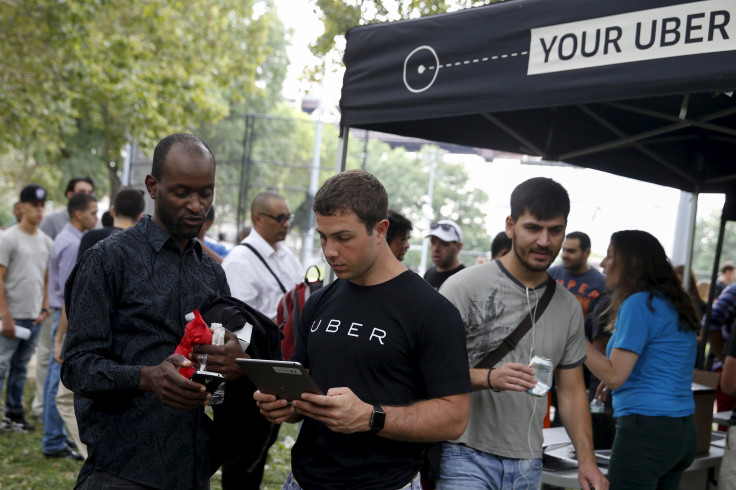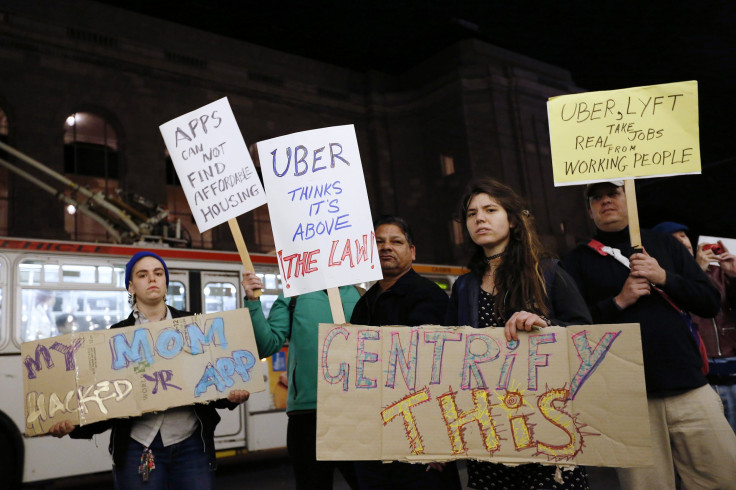Seattle’s Audacious Plan To Let Uber And Lyft Drivers Unionize Raises Eyebrows In The On-Demand Economy

Takele Gobena, 26, drives anywhere between 55 and 80 hours a week for Uber and Lyft in Seattle. He began more than a year and a half ago, quitting his minimum-wage job at the city’s airport after seeing ads for the companies that promised $25 hourly pay. “I thought, ‘This is good news, this is what I’m waiting for,’ ” he says.
An immigrant from Ethiopia, Gobena spent $14,000 on a car that met the ride-hailing firms’ criteria: a 2007 Nissan Sentra. Then, other expenses started piling up. “You pay for the gas, the insurance, you clean your car at least twice a week. All the expenses are on you.”
Because Gobena is classified as an independent contractor -- as opposed to an employee of Uber or Lyft -- the companies aren’t required to reimburse him for these business expenses. When he calculated his hourly pay for last year, factoring in the out-of-pocket costs, he says it came out to $2.64, nearly $7 less than Washington state’s minimum wage.
Independent contractors such as Gobena aren’t just exempt from coverage under wage and overtime laws. They’re also exempt from coverage under the National Labor Relations Act, the cornerstone of American labor law that protects workers’ rights to form unions, speak out on their jobs and bargain with their employers.
If a group of independent contractors complains about their treatment, the business can just terminate the contract, leaving the workers with little to no recourse. For example, Uber can simply deactivate its drivers’ accounts. In other words, whatever the company says, goes.
An audacious new proposal in Seattle would change all that.
‘A Piece Of Innovation’
City legislators are considering a bill that would, for the first time, extend collective-bargaining rights to independent contractors such as Gobena -- a member of a growing slice of the U.S. workforce that is excluded from coverage under major labor laws. The legislation in Seattle would apply to all “for-hire drivers” who have clocked a certain number of hours, ranging from workers at traditional cab companies to those at Uber, Lyft and Sidecar.

Here’s how it would work: After the law took effect, the companies would have to provide the city with the names and contact information for their drivers. Authorities would then hand over the lists to labor organizations wishing to represent the drivers. If a majority of drivers for a particular company say they want representation, then that group becomes the “exclusive driver representative” for that entity, a sort of miniunion. If Uber and Lyft drivers were to give the green light to such groups, then the firms would be forced to sit down and hammer out contracts with them -- or be in violation of city law.
“It’s a piece of innovation in an innovative industry,” says the bill’s sponsor, Councilmember Mike O’Brien. “From what I can tell, this hasn’t been tried before.”
A labor organization called the App-Based Drivers Association, which receives support from a local affiliate of the International Brotherhood of Teamsters union, is widely expected to win any chase to represent drivers. The group worked closely with O’Brien on the bill.
Last week, O’Brien’s proposal breezed through a committee hearing by a 7-0 vote, and is soon headed for a vote by the full council. If it passes, Seattle would set a bold precedent, tackling the contentious question of labor rights in the on-demand economy by enacting public policy instead of leaving it to the courts. The proposal basically sidesteps the core question of high-profile class-action lawsuits against Uber and others: whether drivers are employees or independent contractors.
Miriam Cherry, a professor at the Saint Louis University School of Law who has written about labor in the sharing economy, applauds the effort. “Amid this controversy of ‘who is an employee, who is an independent contractor,’ this is saying, ‘Let’s get away from the labels and start protecting workers,’” she says. “I think that’s moving in the right direction.”
Drivers today are essentially at the whim of the ride-hailing company apps, with little input into pay or working conditions, Cherry says. A firm such as Uber controls everything from the type of vehicles that drivers need to gain access to the apps to the rates they charge customers. It also retains the power to deactivate workers’ accounts. And because drivers are classified as independent contractors, they’re deprived of a robust safety net, having to make all their Social Security contributions themselves and lacking access to employer-paid health insurance and unemployment insurance.
Collective bargaining would add some much-needed balance to the business relationship, Cherry says.
Leonard Smith, a Teamsters' official who works closely with the App-Based Drivers’ Association, says a potential contract with Uber and Lyft could cover things such as the per-mile rates charged by the companies and a grievance process for deactivation.
“I believe the drivers can work out what’s best for them,” Councilmember O’Brien says. “What if you just gave drivers the power to balance the playing field and figure out what’s most important for them?”
Uncharted Legal Waters
Uber and Lyft oppose the bill. Uber representative Kate Downen declined to speak about the measure on the record. Lyft representative Chelsea Wilson says, “We believe the proposed ordinance threatens the privacy of drivers, imposes substantial costs on passengers and the city, and conflicts with longstanding federal law.”
Observers on both sides agree the legislation will face legal challenges. Groups such as the National Right to Work Legal Defense Foundation specialize in this sort of work and would likely flock to Seattle to wage their fight against “compulsory unionism.”
Opponents charge that the bill -- no matter how well-intentioned -- violates federal labor law. They point out the National Labor Relations Act applies to employees, not to independent contractors.
Proponents say that’s not a problem. The NLRA doesn’t cover farm workers or public employees, either, but that hasn’t stopped states from granting similar protections to these groups of workers. Excluding certain workers from coverage under the NLRA doesn’t preclude them from earning the right to collective bargaining under state or local law, the argument goes.
“Uber has signaled that it would argue that the ordinance is preempted by the NLRA,” says Charlotte Garden, an associate professor at the Seattle University School of Law. “I think that argument would fail because the whole point of the ordinance is to cover drivers who wouldn’t otherwise be covered by the NLRA.”

But that likely wouldn’t be the only challenge. Antitrust law generally bars independent contractors from joining together to fix the costs of their services, Garden says. Still, she indicates she believes the novel plan could survive under what’s known as the “state action defense.”
“The general idea is that sovereign states, and then by extension, municipalities, should be able to pursue a range of policies in the public interest -- including policies that might be otherwise be anticompetitive,” Garden says. “There are certain requirements that have to be met in order for the state action defense to apply in a case like this, including that the ordinance be drafted pursuant to a clearly articulated state policy, and that there be governmental oversight of the process and final result.”
According to Garden, “It looks to me like the drafters are aware of this issue, and have made an effort to be responsive to it.”
A Problem That’s Not There?
Besides the proposal’s possibly sparking costly legal battles, critics contend it is simply unnecessary. Both Uber and Lyft say its drivers are doing just fine.
At the very least, it’s clear not everybody is in the same position as Takele Gobena.
Michael Stephens, 46, says he makes $25 to $30 an hour driving for Lyft in Seattle. That figure doesn’t count the roughly $1.50 worth of gasoline he says he burns through every hour or other costs such as car washes and insurance. Stephens didn’t buy a car specifically for the job, either. He works just eight hours a week.
“The best thing about it is we’re not beholden to any schedule. It’s more of a freelance thing to me,” says Stephens, who also works full-time as a broadband technician.
“I would tend to lean against the proposal,” he says. “I kinda like it how it is. I don’t need to be paying union dues.”
Rebecca Smith, the Seattle-based deputy director of the National Employment Law Project, says whether someone’s working part-time or full-time is “irrelevant to what their rights ought to be as a worker.” Her organization recently released a report calling for policymakers to extend labor rights to independent contractors. “This idea that the business model is so different, this complaint is one that we’ve heard over and over again,” she says.
Saint Louis University School of Law’s Cherry says the notion that “ride-sharing” marks an alternative business model appeared more plausible when the companies were first launched. For instance, Lyft was initially marketed as a tool that could connect people who happened to be heading in the same direction. Uber and Lyft have since evolved into highly profitable enterprises that attract workers on a full-time basis.
That professionalization is a “problem of their own making, a byproduct of their own success,” Cherry says. Instead of trying to evade the sorts of legal responsibilities that employers face, the companies should “compete on the basis of their technology being great,” she says. “If this technology is so innovative, so great, then you can give people the wages and benefits they’re supposed to get.”
© Copyright IBTimes 2025. All rights reserved.






















